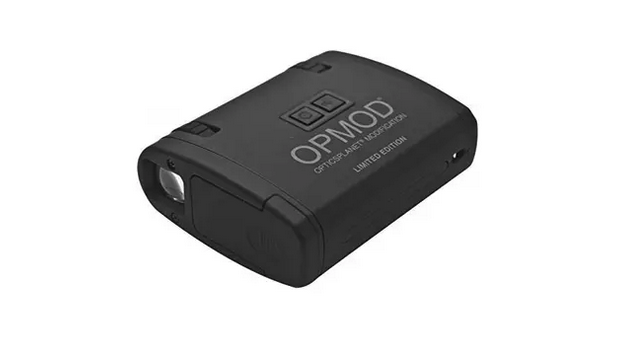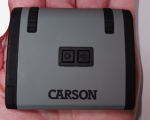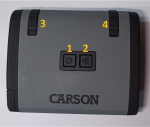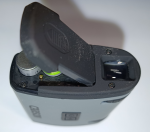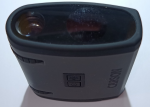Most readers of SurvivalBlog.com understand the advantage that having night vision optics can provide in an emergency or disaster situation. The ability to observe, move and evade in the darkness can provide a significant benefit, especially if you’re trying to find or avoid people that don’t have it. Night vision can make the difference in being able to safely find your way to your objective without advertising your position with a flashlight. Unfortunately, most night vision solutions are typically both expensive and bulky, making it difficult for most people to carry one with them as part of their everyday carry (EDC) or include them in their Get Home Bags (GHB), which means they may not have the capability if something goes belly-up when they’re away from home. Just like a firearm, the best night vision device is the one you have with you when you need it.
Before we get into the actual review it’s important to understand the basics of how night vision works. There are basically three ways a device can allow you to see when there’s little or no light available – light amplification, thermal or infrared. Light amplification works by amplifying any available light many times to provide an image and is typically characterized by the green-tinted images Hollywood loves so much. Thermal works by capturing and displaying the long-infrared range of radiation that everything emits to display differences in temperature, and infrared is similar to thermal except that it captures and displays shorter wavelength infrared radiation (850nm/940nm) as light.
Light amplification and thermal night vision devices tend to be at the larger and more expensive end of the night vision device spectrum; infrared devices tend to be much less expensive and more widely available, and they typically require some sort of infrared light source to work most effectively. Note that the human eye can’t easily detect most infrared radiation, so the light source isn’t visible to people without a night vision device.
The Carson MiniAura Digital Night Vision Monocular (NV-200) is a low-cost and ultra-compact infrared type of night vision device. It is palm-size. Like most digital night vision devices it utilizes a digital imaging sensor and lens at the front to capture infrared light and a small LCD screen in the back to display what it captures to the user; it also has an infrared illuminator to provide a light source.
The Specifications
Here are the basic specifications:
Weight: 2 oz. (58g) without batteries, around 3.5 oz. (99g) with batteries
Dimensions: 2.5” x 2.2” x 1.0” (64mm x 56mm x 25mm)
Objective lens: 10 mm
Focal length: f = 13.5
Aperture: F1.6
Field of view: 19°
Eyepiece dioptric compensation: -4.0 – +2.0 D
Magnification: 1 x (no magnification)
Optical Coating: Yes
Power: 3 x AAA batteries
As you can see this thing is super lightweight and compact – we’re talking easy to carry in a shirt-pocket size and weight. However, like any other technology, there are going to be tradeoffs. In the case of the NV-200 the image quality isn’t as good as the larger and more expensive devices (more on that later). To give you an idea of scale, here’s a picture of the NV-200 in my hand:
Controls
There are four controls on the device:
1. A power button on the top – Press it for 3 seconds and it turns on, press again for a couple of seconds and it turns off.
2. An illuminator button – This controls the built-in infrared illuminator. When you first power the device on the illuminator turns on at 100% – each press of the illuminator button cycles it down through 60%, 30% and off, then one more press to go back to 100%.
3. An eyepiece focus wheel – This allows you to change the focus of the screen view in case you’re farsighted and don’t want to wear reading glasses when you’re using the device. It goes from -4.0 to +2.0 diopters.
4. An objective lens focus wheel – This adjusts the focus of the lens feeding light into the infrared sensor so you can clearly view things at different distances. The focus range is from around 18” (45cm) to 82’+ (25m).
The back of the device has a small square window for viewing the image and a slide-open battery cover:
The front end has two round windows – one for the viewing lens (the small circle on the left in the picture below) and one for the infrared illuminator (the large circle on the right).
There’s also a small notch on the side near the front closest to the illuminator for attaching a wrist lanyard. Note that earlier versions from Carson included a lanyard but they don’t anymore.
There’s also a re-badged version of the NV-200 available from Optics Planet called the Opmod – it’s virtually identical to the Carson version with the following minor differences:
- The casing is black instead of gray
- It’s got an ‘OPMOD’ logo instead of ‘CARSON’
- It comes with a lanyard
- It comes with a nylon slipcase with a belt loop instead of a cloth drawstring bag
Here’s a picture of the two units with the Optics Planet nylon case and lanyard:
As with most infrared night vision devices, the image you see is in black and white (grayscale) – the NV-200 doesn’t support the new ‘false color’ IR technology that’s starting to show up in some high-end devices. Since the camera has a 19° lens, your field of view at 100’ (30m) is going to be around 34’ (10m), so if you want to view a wide area you’ll have to pan the device back and forth. So how far can you see with it? Remember that it doesn’t have any magnification capability so your ability to see at a distance isn’t going to be any better than it would be with your naked eye during daylight, but as with any digital imaging sensor the biggest factor in determining image quality is how much infrared light is being reflected back to the sensor.
I’ve seen ‘official’ specifications that claim the viewing range in total darkness is anything from 82’ (25m) to 146’ (45m) (which is oddly specific), and I’ve seen various online reviews that have claimed something over 200’ (61m). The reality is that it’s going to depend on a lot of conditions such as ambient light (e.g. moonlight or starlight), the types of surfaces in view (reflectivity) and several other factors, but with the built-in infrared illuminator on full you can generally expect to be able to recognize a person at around 50’- 60’ (15m-18m) and be able to identify that a person is present at around 100’. I tried to take some pictures through the view lens using the camera on my cell phone, but either my old phone or my camera skills weren’t up to the task so all I ended up with was a light blurry square.
It’s worth noting that the built-in illuminator provides 850nm infrared light versus 940nm, which means that the LEDs emit a slight glow when they’re on. It’s only noticeable when you’re looking directly into front of the illuminator LED and isn’t really visible beyond 10’ (3m) or so. One thing you need to consider when you’re using an infrared illuminator is that if people you’re trying to avoid also have an infrared or light amplifying night vision device your illuminator will stand out like a flashlight, but so will theirs if they’re using one. You can improve the visible range and picture quality of the device by using an additional source of infrared light such as a DLSR IR flash, IR flashlight, or IR glow stick.
Battery life is good given the compactness of the device. I can get around 2.5-3 hours of continuous use with the illuminator on full using a set of 2200mAh rechargeable AA batteries, and it doesn’t seem to drain batteries heavily when not in use. Remember, this isn’t a primary night vision device that you’re going to full time on an extended nighttime patrol – this is something you can always have with you for emergencies.
Tip: If you’re going to be storing the device for long periods of time with batteries in it, the put a small piece of thin plastic over one of the battery terminals before closing the lid; you’ll have to remove it before using the device, but this will prevent any trickle battery drain and significantly increase the storage life of your batteries.
Another tip: There are a number of companies that are now making Lithium-Ion AAA rechargeable batteries with a built-in USB charging port, which eliminates the need to carry a separate battery charger with you.
Speaking of carrying, the cloth cinch-top case that comes with the Carson version is pretty chintzy, but the nylon pouch that Optics Planet provides with their Opmod version is pretty decent. If you want a better case that can also provide some protection in a potential EMP scenario, the NV-200 fits nicely in the Utility Key Fob Faraday Bag from Silent Pocket. Note that the device isn’t waterproof, or even very water resistant, so I’d recommend a case that provides at least some minimal protection from moisture. A small 3×4 mylar bag also works well. If you’re interested in carrying and using the device in a hands-free manner, there’s a video on YouTube on how to make a mount for it.
Using the device is pretty simple – press the power button for 1-2 seconds, place the view window up to your eye and adjust the focus. For the first use I recommend setting the objective lens focus (the focus wheel towards the front) to it’s furthest focus distance, pointing at something far away, then adjusting the eyepiece focus wheel until the view is crisp. If your vision is different between your eyes you’re better off setting the eyepiece focus for one eye and using that eye consistently so you don’t have to adjust the focus in the future.
So how much will the NV-200 set you back? I’ve seen prices fluctuate between $70 and $200, with a median of around $100. For some reason, prices seem to have gone up in the last few months since I started writing this article, which may be attributable to the China Fu and microchip shortage fiascos. However, I’ve also bought some of the Optics Planet Opmod versions on sale for around $70 a few times over the last few years, so have some patience and shop around to find the best price.
One thing to keep in mind if you live in the US – these are considered night vision devices, which fall under some definitions of a munition and/or controlled technology, and as such may be subject to International Traffic in Arms Regulations (ITAR) or the Commerce Control List (CCL). Depending on which US government bureaucrat or legal expert you talk to, taking them out of the country or allowing a non-US citizen to look through them or even read the users manual could potentially be considered a violation of federal law!
As I stated in the beginning, night vision devices are just like weapons – the best one is the one you have with you when you need it. The NV-200/Opmod fits in a shirt pocket and provides you with a basic night vision option you can easily carry as part of your everyday carry (EDC), get home bag (GHB), etc. without having to break the bank and haul around a large bulky device. Yes, you can find made-in-china IR night vision units for a little more money with better specs, but they’re not something you can easily carry around on a day-to-day basis. As a result, I highly recommend you consider incorporating one or more of these into your carry kit.

